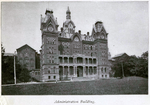Difference between revisions of "Portal:Featured Article Of The Week"
M-Explorer (talk | contribs) |
M-Explorer (talk | contribs) |
||
| (619 intermediate revisions by the same user not shown) | |||
| Line 1: | Line 1: | ||
{{FAformat | {{FAformat | ||
| − | |Title= | + | |Title= Columbus State Hospital |
| − | |Image= | + | |Image= OHcolumbus21.png |
|Width= 150px | |Width= 150px | ||
| − | |Body= | + | |Body= The "Lunatic Asylum of Ohio" was organized by Act of the Thirty-fourth General Assembly, passed March 5, 1835, and Samuel Parsons, William M. Awl and Samuel F. Maccracken were appointed directors. These Directors selected a tract of land about one mile east and north of the State House, in Columbus, comprising thirty acres. This tract fronted south on what is now East Broad street, and the western boundary was near what is now Washington avenue. During the next three years they erected a building on these grounds, at a cost of about sixty-one thousand ($61,000) dollars. The institution accommodated one hundred and twenty patients, and was the first institution for the treatment of the insane organized west of the Alleghenies. On May 21, 1838, William M. Awl, M. D., of Columbus, was elected Medical Superintendent by the Trustees, and the first patient was received on November 30 of that year. |
| − | + | The building was two hundred and ninety-five feet in length and contained one hundred and fifty-three single rooms. The Directors apologized for the apparently extravagant size by saying that it would be required in a few years. Yet it was the only asylum the state then had. Now—1900-1—the state has accommodations for more than seven thousand five hundred patients in the several "State Hospitals" at Cleveland, Columbus, Dayton, Longview, Massillon and Toledo, and every institution is crowded to its full capacity. Dr. Awl was in charge as Superintendent until 1850, a period of twelve years, when he was succeeded by Samuel H. Smith, M. D. He was succeeded in 1852 by E. Kendrick, M. D., and he by George E. Eels, M. D., in June 1854. On August 1, 1855, Dr. Richard Gundry, who later became so prominent in the care of the insane in Ohio and the United States, was appointed Assistant Physician. In July, 1856, Dr. R. Hills, of Delaware, was appointed Superintendent. He held the position for several years, and was succeeded by Dr. William L. Peck. [[Retreat State Hospital|Click here for more...]] | |
| − | |||
| − | In | ||
}} | }} | ||
Latest revision as of 04:22, 2 June 2024
Featured Article Of The Week
Columbus State Hospital
The "Lunatic Asylum of Ohio" was organized by Act of the Thirty-fourth General Assembly, passed March 5, 1835, and Samuel Parsons, William M. Awl and Samuel F. Maccracken were appointed directors. These Directors selected a tract of land about one mile east and north of the State House, in Columbus, comprising thirty acres. This tract fronted south on what is now East Broad street, and the western boundary was near what is now Washington avenue. During the next three years they erected a building on these grounds, at a cost of about sixty-one thousand ($61,000) dollars. The institution accommodated one hundred and twenty patients, and was the first institution for the treatment of the insane organized west of the Alleghenies. On May 21, 1838, William M. Awl, M. D., of Columbus, was elected Medical Superintendent by the Trustees, and the first patient was received on November 30 of that year.
The building was two hundred and ninety-five feet in length and contained one hundred and fifty-three single rooms. The Directors apologized for the apparently extravagant size by saying that it would be required in a few years. Yet it was the only asylum the state then had. Now—1900-1—the state has accommodations for more than seven thousand five hundred patients in the several "State Hospitals" at Cleveland, Columbus, Dayton, Longview, Massillon and Toledo, and every institution is crowded to its full capacity. Dr. Awl was in charge as Superintendent until 1850, a period of twelve years, when he was succeeded by Samuel H. Smith, M. D. He was succeeded in 1852 by E. Kendrick, M. D., and he by George E. Eels, M. D., in June 1854. On August 1, 1855, Dr. Richard Gundry, who later became so prominent in the care of the insane in Ohio and the United States, was appointed Assistant Physician. In July, 1856, Dr. R. Hills, of Delaware, was appointed Superintendent. He held the position for several years, and was succeeded by Dr. William L. Peck. Click here for more...
